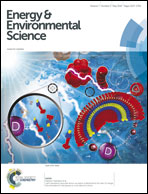Robust nanostructures with exceptionally high electrochemical reaction activity for high temperature fuel cell electrodes
Abstract
Metal nanoparticles are of significant importance for chemical and electrochemical transformations due to their high surface-to-volume ratio and possible unique catalytic properties. However, the poor thermal stability of nano-sized particles typically limits their use to low temperature conditions (<500 °C). Furthermore, for electrocatalytic applications they must be placed in simultaneous contact with percolating ionic and electronic current transport pathways. These factors have limited the application of nanoscale metal catalysts (diameter <5 nm) in solid oxide fuel cell (SOFC) electrodes. Here we overcome these challenges of thermal stability and microstructural design by stabilizing metal nanoparticles on a scaffold of Sm0.2Ce0.8O2−δ (SDC) films with highly porous and vertically-oriented morphology, where the oxide serves as a support, as a mixed conducting transport layer for fuel electro-oxidation reactions, and as an inherently active partner in catalysis. The SDC films are grown on single crystal YSZ electrolyte substrates by means of pulsed-laser deposition, and the metals (11 μg cm−2 of Pt, Ni, Co, or Pd) are subsequently applied by D.C. sputtering. The resulting structures are examined by TEM, SIMS, and electron diffraction, and metal nanoparticles are found to be stabilized on the porous SDC structure even after exposure to 650 °C under humidified H2 for 100 h. A.C. impedance spectroscopy of the metal-decorated porous SDC films reveals exceptionally high electrochemical reaction activity toward hydrogen electro-oxidation, as well as, in the particular case of Pt, coking resistance when CH4 is supplied as the fuel. The implications of these results for scalable and high performance thin-film-based SOFCs at reduced operating temperature are discussed.


 Please wait while we load your content...
Please wait while we load your content...